Nothosaurus mirabilis Münster, 1834

(Da: it.wikipedia.org)
Phylum: Chordata Haeckel, 1874
Subphylum: Vertebrata Cuvier, 1812
Classe: Reptilia Laurenti, 1768
Ordine: Nothosauroidea Baur, 1889
Famiglia: Nothosauridae Seeley, 1889
Genere: Nothosaurus Münster, 1834
Specie e sottospecie
Il genere annovera attualmente le seguenti specie: Nothosaurus mirabilis Münster, 1834 (specie tipo) - Nothosaurus cymatosauroides Sanz, 1983 - Nothosaurus edingerae Schultze, 1970 - Nothosaurus giganteus Münster, 1834 - Nothosaurus haasi Rieppel et al., 1997 - Nothosaurus jagisteus Rieppel, 2001 - Nothosaurus juvenilis Edinger, 1921 - Nothosaurus marchicus Koken, 1893 - Nothosaurus rostellatus Shang, 2006 - Nothosaurus tchernovi Haas, 1980 - Nothosaurus winkelhorsti Klein and Albers, 2009 - Nothosaurus yangjuanensis Jiang et al., 2006 - Nothosaurus youngi Li & Rieppel, 2004 - Nothosaurus zhangi Liu et al., 2014.
Descrizione
Il Nothosaurus, il cui nome significa "falsa lucertola" dal greco antico nothos ossia "illegittimo"/"falso" e sauros, "lucertola", aveva un corpo dall'aspetto allungato, con collo e coda affusolati e un cranio lungo e piatto. Le zampe, corte, erano poste ai lati del corpo e terminavano con cinque dita, molto probabilmente erano palmate; potevano essere utilizzate anche per muoversi, in modo impacciato, sulla terraferma, possedeva, inoltre, un cranio allungato Queste caratteristiche erano a tutti gli effetti notevoli adattamenti per una vita acquatica: il notosauro, probabilmente, viveva in acque costiere, predando pesci e altre creature marine per mezzo dei lunghi denti. Per quanto riguarda la nicchia ecologicaoccupata da questo animale, non doveva essere molto diversa da quella di foche e otarie. Il notosauro era un animale relativamente grande, e le varie specie misuravano dagli uno ai quattro metri di lunghezza. Tra le varie specie, una delle più note è il Nothosaurus giganteus, della Germania. In Italia, negli scisti ittiolitici di Besano (provincia di Varese) è stato ritrovato un grande esemplare, precedentemente noto come Paranothosaurus amsleri, oggi conosciuto come la specie N. giganteus. Sono state nominate numerose specie, ma alcune delle specie sono state in seguito sinonimizzate e considerate non valide. Uno di questi, è la specie N. procerus, oggi considerato un sinonimo junior di N. marchicus. Altre specie ora considerati sinonimi junior di N. marchicus comprendono N. crassus, N. oldenburgi, N. raabi, N. schroderi, N. venustus e il recentemente nominato N. winterswijkensis. I sinonimi junior della specie N. giganteus, la seconda specie più grande di Nothosaurus, comprendono le specie N. andriani, N. angustifronis, N. aduncidens, N. baruthicus e N. chelydrops. A livello di specie l'analisi filogenetica di nothosauridae è stata eseguita da Liu et al., nel 2014, e comprendeva tutte le specie valida noto della famiglia di Nothosaurus parte di Lariosaurus stensioi (tipo di Micronothosaurus), Nothosaurus cymatosauroides e Ceresiosaurus lanzi. A causa dell'inclusione di altri nothosauridi diversi da Nothosaurus, la monofilia di Nothosaurus è stato testato per la prima volta. L'analisi ha rilevato che sia Lariosaurus sia Nothosaurus siano polifiletici per quanto riguarda l'un l'altro e tutti gli altri generi della famiglia, facendo una revisione sistematica di questi due generi necessari.
Diffusione
Genere estinto di rettile sauropterygio vissuto nel periodo Triassico, circa 240-210 milioni di anni fa, in quelle che oggi sono il Nord Africa, Europa e Cina. È il membro più noto e meglio conosciuto dell'ordine di nothosauria. Uno scheletro completo della specie Nothosaurus raabi, ormai sinonimo di N. marchicus, può essere visto nel Museo di Storia Naturale di Berlino.
Bibliografia
–C. Diedrich, The vertebrates of the Anisian/Ladinian boundary (Middle Triassic) from Bissendorf (NW Germany) and their contribution to the anatomy, palaeoecology, and palaeobiogeography of the Germanic Basin reptiles, in Palaeogeography, Palaeoclimatology, Palaeoecology, vol. 273, n. 1, 2009, pp. 1-16.
–O. Rieppel, The status of the sauropterygian reptile Nothosaurus juvenilis from the Middle Triassic of Germany, in Palaeontology, vol. 37, 1994, pp. 733-745.
–O. Rieppel e Wild, R., Nothosaurus edingerae Schultze, 1970: diagnosis of the species and comments on its stratigraphical occurrence, in Stuttgarter Beiträge für Naturkunde, Serie B, 1994.
–O. Rieppel, Mazin, J.-M. e Tchernov, E., Speciation along rifting continental margins: a new Nothosaur from the Negev (Israël), in Comptes Rendus de l'Académie des Sciences Series IIA, vol. 325, n. 12, 1997, pp. 991-997.
–O. Rieppel, Mazin, J.-M. e Tchernov, E., Sauropterygia from the Middle Triassic of Makhtesh Ramon, Negev, Israel, in Fieldiana, vol. 1, n. 40, 1999.
–O. Rieppel e Hagdorn, H., Fossil reptiles from the Spanish Muschelkalk (mont-ral and alcover, province Tarragona), in Historical Biology: An International Journal of Paleobiology, vol. 13, n. 1, 1998, pp. 77-97.
–Q.-H. Shang, New information on the dentition and tooth replacement of Nothosaurus (Reptilia: Sauropterygia), in Palaeoworld, vol. 16, 2007, pp. 254-263.
–J. Li e Rieppel, O., A new nothosaur from Middle Triassic of Guizhou, China, in Vertebrata PalAsiatica, vol. 42, n. 1, 2004, pp. 1-12.
–W. Jiang, Maisch, M. W., Hao, W., Sun, Y. e Sun, Z., Nothosaurus yangjuanensis n. sp. (Reptilia, Sauropterygia, Nothosauridae) from the middle Anisian (Middle Triassic) of Guizhou, southwestern China, in NeuesJahrbuch für Geologie und Paläontologie, Monatshefte, vol. 5, 2006, pp. 257-276.
–Q.-H. Shang, A new species of Nothosaurus from the early Middle Triassic of Guizhou,China, in Vertebrata PalAsiatica, vol. 44, n. 3, 2006, pp. 237-249.
–Jun Liu, Shi-xue Hu, Olivier Rieppel, Da-yong Jiang, Michael J. Benton, Neil P. Kelley, Jonathan C. Aitchison, Chang-yong Zhou, Wen Wen, Jin-yuan Huang, Tao Xie and Tao Lv, A gigantic nothosaur (Reptilia: Sauropterygia) from the Middle Triassic of SW China and its implication for the Triassic biotic recovery, in Scientific Reports, vol. 4, 2014, pp. Article number 7142.
–P. C. H. Albers, A new specimen of Nothosaurus marchicus with features that relate the taxon to Nothosaurus winterswijkensis, in Vertebrate Palaeontology, vol. 3, n. 1, 2005, pp. 1-7.
–P.C.H. Albers, New Nothosaurus skulls from the Lower Muschelkalk of the western Lower Saxony Basin (Winterswijk, the Netherlands) shed new light on the status of Nothosaurus winterswijkensis, in Netherlands Journal of Geosciences, vol. 90, n. 1, August 2011, pp. 15-22.
–N. Klein e Albers, P. C. H., A new species of the sauropsid reptile Nothosaurus from the Lower Muschelkalk of the western Germanic Basin, Winterswijk, The Netherlands, in Acta Palaeontologica Polonica, vol. 54, n. 4, 2009, pp. 589-598.
–H. Schroder, Wirbeltiere der Riidersdorfer Trias, in Abhandlungen der Preussischen Geologischen Landesanstalt, Neue Folge, vol. 65, 1914, pp. 1-98.
–O. Rieppel e Wild, R., A revision of the genus Nothosaurus (Reptilia. Sauropterygia) from the Germanic Triassic with comments on the status of Conchiosaurus clavatus, in Fieldiana, vol. 1, n. 34, 1996, pp. 1-82.
–A new specimen of Lariosaurus xingyiensis (Reptilia, Sauropterygia) from the Ladinian (Middle Triassic) Zhuganpo Member, Falang Formation, Guizhou, China, in Journal of Vertebrate Paleontology, vol. 37, n. 2, 4 marzo 2017, pp. e1278703.
–Palmer, D. (a cura di), The Marshall Illustrated Encyclopedia of Dinosaurs and Prehistoric Animals, London, Marshall Editions, 1999, p. 72.
–(LiveScience) Tia Ghose, "Ancient long-necked 'sea monsters' rowed their way to prey", reporting the scientific article published in Nature Communications 11 June 2014: accessed 28 November 2014.
–(EN) SCP-4307 - SCP Foundation, su The SCP Foundation. URL consultato il 10 dicembre 2023.
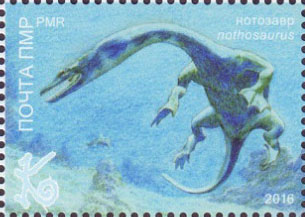
|
Data: 18/03/2016
Emissione: Animali preistorici acquatici Stato: Transnistria Nota: Emesso in un foglietto di 4 v. diversi |
|---|
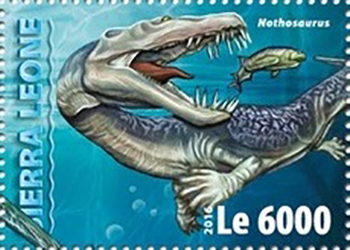
|
Data: 25/03/2016
Emissione: Animali preistorici marini Stato: Sierra Leone |
|---|
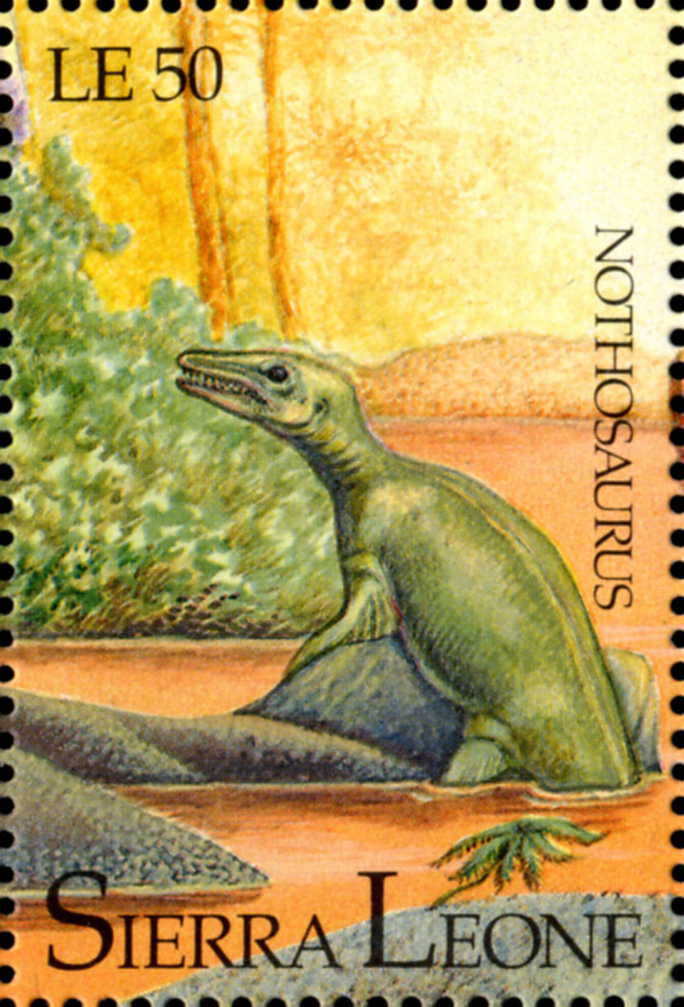
|
Data: 08/06/1992
Emissione: Animali preistorici Stato: Sierra Leone |
|---|
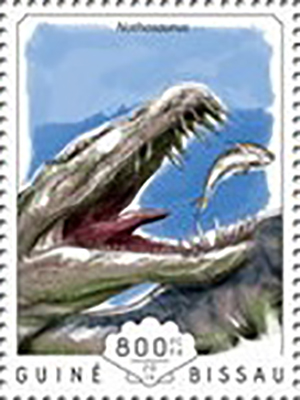
|
Data: 05/11/2014
Emissione: Animali preistorici acquatici Stato: Guinea-Bissau |
|---|
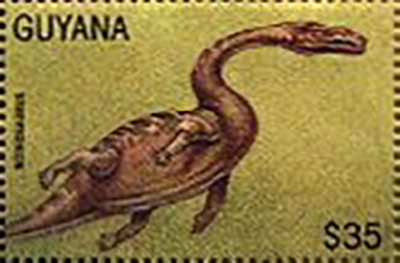
|
Data: 29/01/1991
Emissione: Animali preistorici Stato: Guyana |
|---|
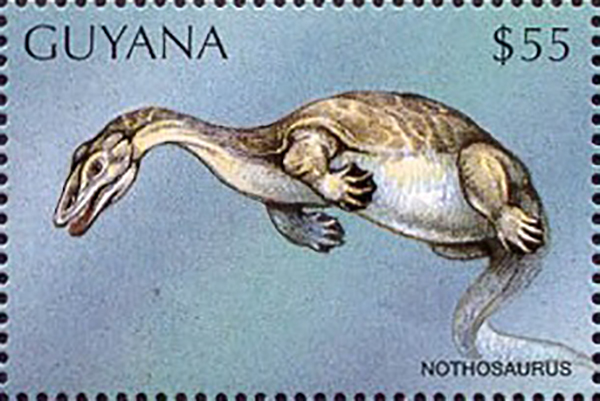
|
Data: 23/02/1998
Emissione: Animali preistorici Stato: Guyana Nota: Emesso in un foglietto di 9 v. diversi |
|---|
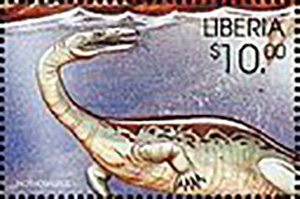
|
Data: 22/11/1999
Emissione: Animali preistorici Stato: Liberia |
|---|

|
Data: 06/03/1994
Emissione: Dinosauri acquatici Stato: Montserrat |
|---|

|
Data: 03/07/2017
Emissione: Animali preistorici acquatici Stato: Niger Nota: Emesso in un foglietto di 4 v. diversi |
|---|
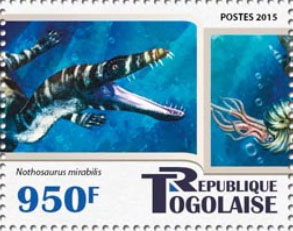
|
Data: 15/06/2015
Emissione: Animali preistorici acquatici Stato: Togo Nota: Emesso in un foglietto di 4 v. diversi |
|---|
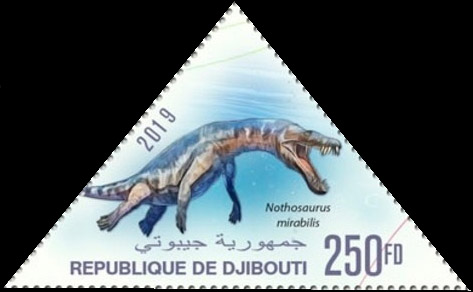
|
Data: 14/03/2019
Emissione: Animali preistorici acquatici Stato: Djibouti Nota: Emesso in un foglietto di 4 v. diversi |
|---|